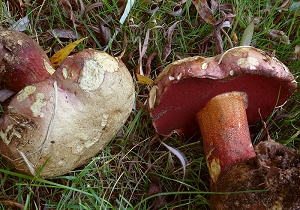| Boletus rhodoxanthus (Krombh.) Kallenb. |
|
|
|
|
|
|
The cap is whitish with yellow or pink shades, even pinker towards the margin, sturdy, convex then expanded. The cap surface is covered with a grey-pink topping, vanishing when touched. The stem is stout, club-shaped, bright yellow and vinaceous red at the base. It is covered with a purple red network on a yellow-orange background, made of elongated and dotted cells, vanishing downwards to the greenish-grey base. The flesh is firm, lemon yellow, but reddish at the base, turning light blue moderately in the cap when in contact with air, before becoming yellow; its taste is sweet; the odour is strong and mushroomy; The tubes are yellow, slightly turning blue when exposed to air. The pores are small, golden yellow then bright blood red, turning blue when pressed. The spore print is olive brown. It grows in broad-leaved woods, on a rather calcareous soil, essentially with oak, beech. The fruiting period takes place from July to November.
Distinctive features : pinkish cap covered with a whitish-pink frosty topping; stem covered with a blood-red network; yellow pores becoming bright red, tuning blue when pressed Boletus rhodoxanthus is rare and localised in the forest of Rambouillet, and is quite rare, more generally speaking . | ||
|
page updated on 14/01/18

